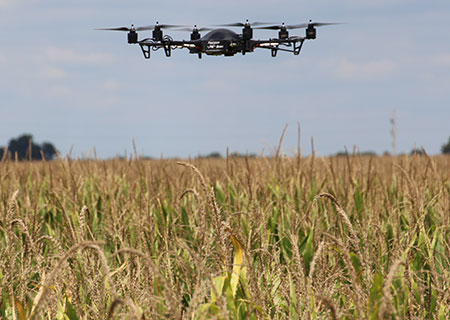
Agricultural News
Choctaw-Noble Project Explores Safety, Practicality of Drones in Rural Communities
Tue, 09 Apr 2019 15:31:53 CDT
 In May 2018, the United States Department of Transportation Secretary Elaine L. Chao announced 10 Unmanned Aircraft Systems (UAS) Integration Pilot Program (IPP) sites representing a mix of states, counties, cities and tribes. The purpose of the program is to accelerate safe UAS (i.e., drone) integration into the national airspace system by:
In May 2018, the United States Department of Transportation Secretary Elaine L. Chao announced 10 Unmanned Aircraft Systems (UAS) Integration Pilot Program (IPP) sites representing a mix of states, counties, cities and tribes. The purpose of the program is to accelerate safe UAS (i.e., drone) integration into the national airspace system by:
1. Identifying ways to balance local and national interests related to drone integration.
2. Improving communications with local, state and tribal jurisdictions.
3. Addressing security and privacy risks.
4. Accelerating the approval of operations that currently require special authorizations.
The Choctaw Nation of Oklahoma was one of the 10 IPP sites selected as well as the only tribal government lead participant. The Choctaw Nation entered into a key strategic partnership with the Noble Research Institute.
The Choctaw Nation program focuses on typical rural and agricultural community applications of drone technology, including addressing both safety and public stakeholder concerns.
Additionally, the unique partnership with Noble is facilitating analyses of the practical applications of drone technology in agriculture, including viability for various applications and assessing potential return on investment (ROI) for a typical agricultural producer.
The Noble Research Institute is excited about the partnership with the Chickasaw Nation and the potential of drone technology for rural communities and for agricultural producers.
DRONES IN AGRICULTURE: ARE THEY PRACTICAL?
There is a modern adage about technology called Amara's Law that states, "e tend to overestimate the effect of a technology in the short run and underestimate the effect in the long run." This adage succinctly describes in a way the emergence of small drones. Drones have emerged on the public stage within the last decade with a mixture of enthusiasm, hype and even concern.
In 2013, the Association for Unmanned Vehicle Systems International (AUVSI) published an economic forecast that included a prediction that around 80 percent of the civil market for drones would be for agricultural purposes, approximately 10 times the predicted market size for public safety applications. You can see the full report at www.auvsi.org/our-impact/economic-report.
This forecast heightened interest in the agriculture industry and spawned early investments and startups each seeking to "cash in" on the agricultural market for drone technology. Unfortunately, many of these initial endeavors lacked insight into the practical economics of agricultural production and lacked involvement of subject matter experts from the agricultural community.
The Noble Research Institute, with its rich history of agricultural demonstrations and research, takes great pride in capitalizing on opportunities to further such a potentially powerful piece of technology for the agricultural industry.
This strategic partnership will allow Noble the opportunity to use the practical knowledge that producers provide to help steer the policies that regulate UAS in the agriculture space.
POTENTIAL BENEFITS
The Noble Research Institute is predicting two types of benefits for drone technology within an agricultural production environment:
1. Improvements in efficiencies (yields, profits, etc.).
2. Improvements in safety within the agricultural environment.
A common saying about drone technology is that it can help address the 4 Ds: tasks that are dull, dirty, dangerous and difficult. Agriculture is among the 10 most dangerous occupations in the country, according to the Bureau of Labor Statistics. The Choctaw Nation's UAS program began with the idea that agricultural worker safety could be improved by using drones to accomplish specific tasks.
REMOTELY REBAITING FERAL HOG TRAPS
An early demonstration involved using drones to remotely rebait traps for feral hogs (in this case the feral hog trap used was the Boarbuster™). In August 2018, a drone (developed and flown by Oklahoma State University) remotely delivered 10 pounds of ordinary dried corn to a feral hog trap several thousand feet away from the drone operator. The mission was successfully repeated several times with an accurate delivery in the trap each time.
The feral hog trap rebait mission was selected not necessarily to demonstrate a value for ROI, but rather to demonstrate a potential class of applications that could possibly reduce exposure to workplace hazards. In this example, the use of a drone would reduce the need for a worker to travel to perform a relatively routine and simple (but dull, dirty and dangerous) task.
A large number of accidents within an agricultural producer's environment occur as a result of travel within remote agricultural properties. If the amount of travel and movement can be minimized, then it may reduce the likelihood of injuries to farm workers.
Of course, this is based on the assumption that drones can be safely integrated into the airspace and that safety issues related to drones can be effectively managed. The Noble Research Institute is addressing some of these safety issues as part of the program, and we are encouraged and optimistic about the early results.
DRONES COULD COUNT COWS
The Noble Research Institute is also encouraged by the potential applications of drone technology in agriculture that were mostly ignored when the initial drone industry forecasts emerged.
Although the overwhelming majority of early drone companies focused on crop applications, we are recognizing significant benefits for herd management. These applications range from using artificial intelligence and computer vision to accurately count and inventory herd animals to using a variety of sensors to help locate lost members of a herd quickly and efficiently.
Source - Noble Research Institute
WebReadyTM Powered by WireReady® NSI
Top Agricultural News
More Headlines...





